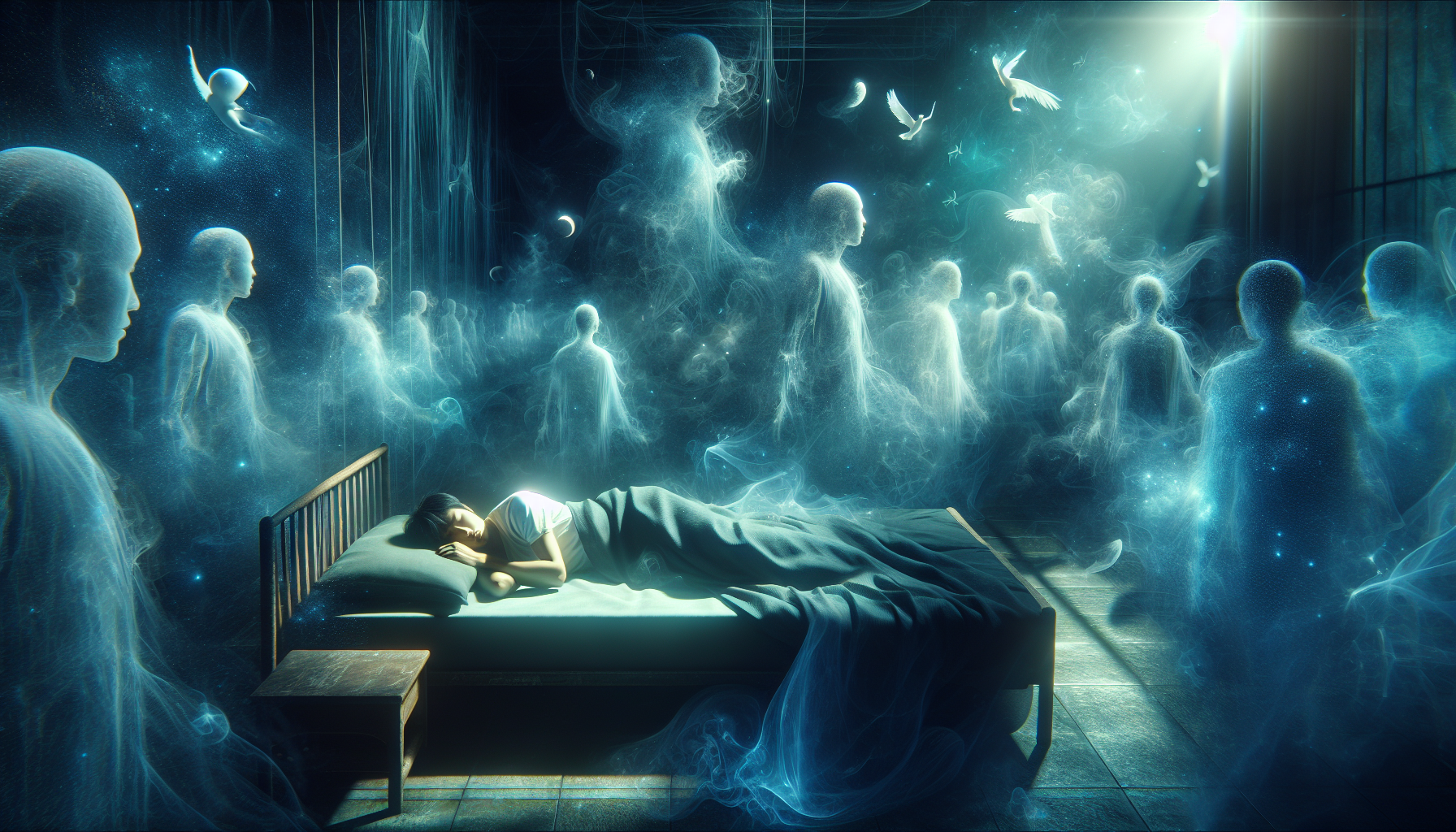In the quiet corners of our minds, where reality and imagination intertwine, lies a realm as enigmatic as it is fascinating: the world of dreams. Every night, as we surrender to the embrace of sleep, we embark on a journey through this mysterious domain, where the laws of logic and time seem to bend and blend. Among the myriad of dream scenarios we encounter, one particular phenomenon stands out for its peculiar and perplexing nature: dreaming of strangers. These unknown faces, which materialize uninvited in our slumber, often leave us pondering their significance long after we awaken. What do these mysterious visitors represent, and why do they hold such a prominent place in our subconscious theater?
The concept of dreaming of strangers touches a universal chord, resonating with dreamers across cultures and generations. We’ve all experienced it—a faceless figure, a vague silhouette, or an unknown companion who seems to hold the key to a deeper understanding of our inner selves. This phenomenon raises a compelling question: are these strangers merely figments of our imagination, or do they carry messages from the depths of our psyche? As we delve deeper into the labyrinthine corridors of the subconscious, we discover that these dream visitors might be more than mere apparitions—they might be symbolic reflections of our hidden desires, fears, and unresolved conflicts. 💤
In this comprehensive exploration, we will unravel the mystery of dreaming of strangers by examining several intriguing aspects. First, we will delve into the science of dreaming, exploring how our brains create these vivid nocturnal narratives and what current research suggests about the role of strangers in our dreams. By understanding the cognitive processes behind dreaming, we gain insights into why certain faces appear and how they might be linked to our waking lives. Next, we will explore the psychological interpretations of these dreams, drawing on the theories of renowned psychologists such as Carl Jung and Sigmund Freud, who have long pondered the symbolic language of the subconscious. Their insights provide a fascinating framework for interpreting the presence of strangers in our dreams as representations of our inner worlds.
Moreover, we will take a cultural journey, examining how different societies interpret and value dreams of strangers. From ancient civilizations to modern-day spiritual practices, dreaming has always been a source of inspiration and guidance. Understanding these diverse perspectives can enrich our interpretation of our own dreams, offering new angles from which to view our subconscious experiences. We will also address the potential implications of dreaming of strangers on our personal growth and self-awareness. Can these dreams serve as catalysts for change, prompting us to confront and embrace aspects of ourselves we might otherwise overlook?
Finally, we’ll provide practical advice on how to engage with and interpret your dreams of strangers. Techniques such as dream journaling, meditation, and mindfulness can enhance your ability to recall and understand these nocturnal encounters, transforming them from fleeting curiosities into powerful tools for introspection. By nurturing a deeper connection with our subconscious minds, we open the door to a richer, more meaningful dialogue with ourselves—a dialogue that can lead to profound personal insights and transformative life changes. 🌙
As you immerse yourself in the unfolding narrative of this article, prepare to embark on a captivating journey through the intricacies of the human mind. Together, we will dive deeper into the subconscious, exploring the vibrant tapestry of dreams that connect us all. Whether you’re a seasoned dreamer or someone newly curious about the mysteries of the mind, this exploration promises to unlock new dimensions of understanding and inspire a fresh perspective on the strangers who inhabit your dreams. Let us begin this odyssey into the unknown, and discover what secrets these nocturnal visitors might hold.
The Enigmatic World of Dreams
Dreaming is a universal human experience that has fascinated cultures for millennia. Whether they’re vivid recollections of fantastical adventures or vague fragments that linger upon waking, dreams are a window into the depths of our subconscious minds. Among these nocturnal narratives, dreams about strangers stand out as particularly intriguing. Why do we dream of people we’ve never met? What does it signify about our subconscious? Let’s dive into the mysterious world of dreaming of strangers and explore what these dreams could mean.
Dreaming of strangers can often feel puzzling, yet it is surprisingly common. These strangers may have familiar faces, or they may appear as complete unknowns, blending into the narrative of our dreams. Such dreams might leave us questioning the relevance of these characters in our waking lives. Psychologists and dream analysts suggest various interpretations, from representing aspects of our own personality to being symbolic manifestations of our emotions and thoughts.
The study of dreams is a multifaceted field, incorporating insights from psychology, neuroscience, and even cultural studies. Dreaming of strangers can be analyzed through different lenses, each offering unique perspectives on what these dreams might signify. From the psychological interpretation to the scientific perspective, and the cultural narratives surrounding dreams, understanding the meaning behind dreaming of strangers is a journey through the complexities of the human mind.
Psychological Perspectives on Dreaming of Strangers
In the realm of psychology, dreams are often seen as reflections of our subconscious desires and fears. When it comes to dreaming of strangers, Carl Jung’s theory of the collective unconscious provides a fascinating insight. Jung believed that our dreams tap into a shared reservoir of archetypes and symbols common to all humans. Strangers in dreams could represent unknown aspects of ourselves, embodying traits or desires that we have yet to acknowledge consciously.
Freudian theory, on the other hand, might interpret dreams of strangers as manifestations of repressed emotions or unresolved conflicts. According to Sigmund Freud, dreams are a form of wish fulfillment, allowing the dreamer to confront hidden desires. Strangers in dreams could symbolize parts of our psyche that we are not yet ready to confront in waking life, acting as a safe space for exploring these latent emotions.
Another psychological perspective considers strangers in dreams as representations of change or new experiences. Our minds often process new information or anticipate future events through dreams. Strangers might symbolize the unknown, reflecting our feelings towards upcoming changes or challenges. This interpretation aligns with the concept of dreams as a cognitive processing tool, where our brains work through thoughts and emotions while we sleep.
Neuroscientific Insights into Dreaming
From a neuroscientific standpoint, dreams are a byproduct of the brain’s activity during sleep, particularly during the Rapid Eye Movement (REM) phase. The brain is highly active during REM sleep, and it is during this stage that most vivid dreaming occurs. Strangers in dreams might simply be a result of the brain’s random firing of neurons, constructing narratives from bits and pieces of memories and sensory inputs.
Interestingly, research suggests that dreaming serves essential functions, such as memory consolidation and emotional regulation. During REM sleep, the brain processes recent experiences and integrates them with existing knowledge. Strangers in dreams could be symbolic of the brain’s attempt to organize and make sense of disparate information, weaving a narrative from the randomness of neural activity.
Moreover, neuroscientific studies indicate that the brain’s default mode network (DMN) is active during dreaming. The DMN is associated with self-referential thoughts and daydreaming, suggesting that dreams, including those featuring strangers, might involve a deep introspective process. This network might be responsible for creating complex dream scenarios that allow for self-reflection and problem-solving, even if the dream’s content seems unrelated to our daily lives.
Cultural Interpretations of Dreaming of Strangers
Throughout history, cultures worldwide have attributed various meanings to dreams and the appearance of strangers within them. In many cultures, dreams are seen as messages from the spiritual realm, offering guidance or warnings. Strangers in dreams might be viewed as messengers or guides, symbolizing spiritual insights or divine intervention.
For instance, in some Native American traditions, dreams are considered a bridge to the spirit world. Strangers appearing in dreams might be interpreted as spirit guides or ancestors offering wisdom and protection. Similarly, in ancient Greek culture, dreams were believed to be communications from the gods. Strangers in these dreams could represent divine messengers, carrying important messages for the dreamer.
In modern Western culture, dreams are often interpreted more symbolically, reflecting personal and psychological meanings. However, the influence of cultural narratives persists, and dreams of strangers might still be seen as omens or symbols of significant life changes. This interplay between cultural beliefs and psychological interpretations highlights the rich tapestry of meaning that dreams, particularly those involving strangers, can hold.
Analyzing Dream Symbols and Their Meanings
When delving into the symbolic meaning of strangers in dreams, it is essential to consider the context and emotions associated with the dream. The interpretation of dream symbols can vary widely depending on the individual’s personal experiences and cultural background. Here are some common interpretations of stranger-related dream symbols:
- **The Unknown:** Strangers often symbolize the unknown or unfamiliar aspects of life. They might represent fears or anxieties related to new situations or changes.
- **Hidden Aspects of Self:** In many dream interpretations, strangers are seen as reflections of the dreamer’s subconscious mind, embodying traits or desires that have not yet been acknowledged.
- **Messages or Warnings:** Strangers might also be interpreted as messengers, delivering important messages or warnings about the dreamer’s waking life.
Understanding these symbols requires introspection and an exploration of the dreamer’s personal context. Keeping a dream journal and reflecting on recurring themes or emotions can provide valuable insights into the significance of strangers in dreams.
Exploring the Personal Significance of Dreams
While general interpretations provide a framework for understanding dreams about strangers, the personal significance of these dreams is unique to each individual. To truly grasp the meaning of such dreams, it is crucial to consider one’s own life experiences, emotions, and current circumstances. Self-reflection and mindfulness can help unravel the layers of meaning within a dream, offering personal insights and understanding.
Incorporating techniques such as dream journaling can be a valuable tool in this process. By recording and analyzing dreams, individuals can identify patterns or recurring themes that might reveal underlying concerns or desires. This practice not only aids in dream interpretation but also enhances self-awareness and personal growth.
Moreover, discussing dreams with a therapist or dream analyst can provide additional perspectives and insights. Professional guidance can help uncover hidden meanings and offer support in navigating the complex emotions and thoughts that dreams might evoke. Engaging with dreams in this way can be a transformative journey, leading to deeper self-discovery and understanding.
The Role of Dreams in Emotional Processing
Dreams, including those involving strangers, play a crucial role in emotional processing and regulation. They provide a safe space for the mind to explore and express emotions that might be challenging to confront in waking life. By allowing the subconscious to process these emotions, dreams can aid in emotional healing and resolution.
During REM sleep, the brain processes and integrates emotions, helping to regulate mood and reduce stress. This emotional processing function is vital for mental well-being, as it allows individuals to work through complex emotions in a non-threatening environment. Strangers in dreams might be a part of this process, representing unresolved feelings or aspects of the self that require attention.
Practical Steps to Understand Your Dreams
Embarking on a journey to understand your dreams involves both introspection and exploration. Here are some practical steps to help you uncover the meaning behind your dreams, especially those featuring strangers:
- **Keep a Dream Journal:** Record your dreams as soon as you wake up. Note down the details, emotions, and any symbols that stand out.
- **Reflect on Personal Context:** Consider your current life circumstances, emotions, and any changes or challenges you are facing.
- **Seek Professional Guidance:** Consult with a therapist or dream analyst to gain deeper insights into your dreams.
By incorporating these practices, you can cultivate a deeper connection with your subconscious mind and unlock the potential for personal growth and self-discovery. Remember, dreams are a unique and personal experience, and understanding them requires patience and curiosity.
As you delve into the enigmatic world of dreams, keep in mind that the journey is as important as the destination. Embrace the mystery and allow yourself to explore the depths of your subconscious mind, uncovering the rich tapestry of meaning that dreams, particularly those involving strangers, have to offer.
For a visual exploration of dream interpretation, watch this insightful video: The Power of Dreams by PsycheTruth. 📽️

Conclusion
As we reach the conclusion of our exploration into the intriguing phenomenon of dreaming about strangers, it is essential to revisit and distill the core insights we have uncovered throughout this article. Dreams, those mysterious narratives that unfold in the depths of our subconscious, have long fascinated humanity, serving as windows into the unexplored territories of our minds. At the heart of this exploration lies a curiosity about why our subconscious often populates our dreams with faces we do not recognize.
Firstly, we delved into the nature of dreams themselves, understanding them as a complex interplay of memories, emotions, and cognitive processes that our brain engages in during sleep. Dreams are not mere sequences of random images but are deeply tied to our psychological and emotional states. When we dream of strangers, these figures may represent unfamiliar parts of ourselves or symbolically manifest unresolved issues or desires. This process highlights the intricate workings of our subconscious and its capacity to create narratives that speak to our innermost thoughts and feelings.
We then examined the theories proposed by psychologists and neuroscientists, offering perspectives on why strangers might appear in our dreams. Sigmund Freud, for instance, suggested that strangers in dreams could be projections of our repressed desires or fears. Carl Jung, on the other hand, saw these strangers as archetypal figures, representing universal human experiences. Modern neuroscience adds another layer, indicating that the brain’s way of processing and organizing information might lead to the amalgamation of various characteristics into unfamiliar dream characters.
In exploring the potential meanings behind dreaming of strangers, we also considered cultural and social influences. Across different cultures, dreams hold varied significance and interpretations, often reflecting societal values and beliefs. This cultural lens offers a broader understanding of how dreams of strangers might be interpreted differently depending on one’s background and experiences.
Furthermore, the phenomenon of recurring dreams featuring strangers was addressed, suggesting that such dreams could signal persistent issues or themes in one’s waking life that need attention. These strangers might embody aspects of personal growth or change, urging the dreamer to confront certain realities or emotions they might be avoiding.
A significant part of our discussion also revolved around the practical steps individuals can take to decode their dreams, using them as tools for personal insight and growth. Keeping a dream journal, for instance, helps in recognizing patterns and symbols that recur in dreams, offering clues to the dreamer’s subconscious mind. Engaging in reflective practices such as meditation or therapy can further aid in understanding the messages our dreams might be conveying.
As we synthesize these insights, it becomes clear that dreams, especially those involving strangers, are rich with meaning and potential for self-discovery. They serve as a bridge between the conscious and unconscious, offering us glimpses into our deepest fears, desires, and unacknowledged aspects of our personalities. By paying attention to these dreams, we can embark on a journey of introspection and growth, learning more about ourselves and the world around us.
In conclusion, the mystery of dreaming about strangers invites us to delve deeper into our subconscious and embrace the enigmatic nature of our dreams. It is an invitation to explore the vast landscapes of our minds and uncover the stories waiting to be told. As you reflect on what you have learned, consider the possibilities that lie within your dreams. How might they guide you toward greater self-awareness or inspire you to address certain aspects of your life? 🧠
We encourage you to share your experiences and thoughts in the comments below. Have you ever dreamt of strangers, and what did those dreams mean to you? Engaging in this conversation not only enriches our understanding but also builds a community of shared experiences and insights. Feel free to share this article with others who might be intrigued by the mysteries of dreaming. Together, let’s continue to unravel the secrets of our subconscious and embrace the journey of self-discovery that our dreams offer.
For further exploration on this topic, consider visiting these resources:
1. [The Science of Dreaming](https://www.sleepfoundation.org/dreams)
2. [Understanding the Psychology of Dreams](https://www.psychologytoday.com/us/basics/dreaming)
May your dreams be vivid, enlightening, and a source of endless curiosity. 🌟
Gabriel is a visual storyteller and dream archivist whose work explores the fragile boundary between memory and imagination. Through layered visuals and symbolic design, Gabriel captures the fleeting essence of dreams — those strange, beautiful, and sometimes haunting fragments that drift through sleep and linger in waking thought.
His creative journey is rooted in a deep fascination with the subconscious and the imagery it conjures. From half-remembered landscapes to recurring symbols and surreal encounters, each piece Gabriel brings to life becomes a portal into the inner archive — where time distorts, meanings shift, and personal mythology takes form.
With a background in handcrafted artistry and visual composition, Gabriel merges intuition with intention. His work doesn’t merely depict dreams; it preserves them, translating ephemeral moments into tangible expressions that evoke emotion, curiosity, and quiet revelation. Each visual is both a record and an invitation to explore the rich terrain of inner life.
Through illustrated dream journals, symbolic studies, and visual essays, Gabriel invites others to connect with the poetic architecture of their subconscious landscapes. His art becomes a mirror — not only of what we see at night, but of what we carry deep within.
His work is a tribute to:
-
The fragile beauty of forgotten dreams
-
The language of symbols in the subconscious mind
-
The inner worlds we visit but rarely name
Whether you’re a lucid dreamer, a seeker of hidden meanings, or someone fascinated by the mystery of sleep-born stories, Gabriel welcomes you to step into a space where dreams are not lost — they are archived, one vision, one sketch, one silent narrative at a time.





